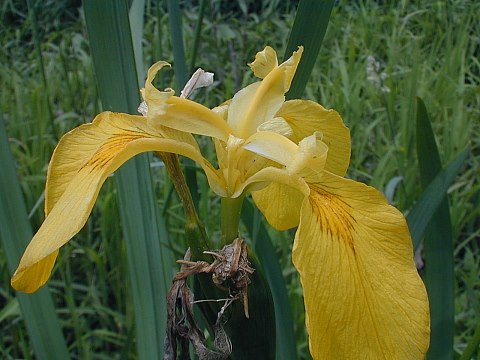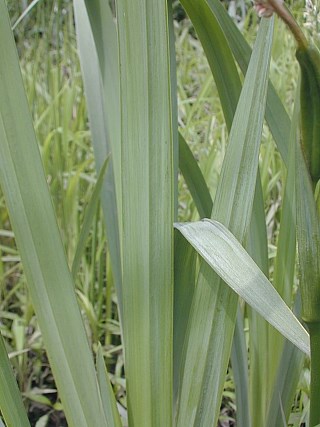Description: This perennial wildflower is about 2½–3' tall, consisting of large erect basal leaves and a flowering stalk. Usually, the larger basal leaves are a little taller than the flowering stalk. The stiff basal leaves are pale blue-green to green, sword-shaped, glabrous, and glaucous; they have parallel venation and smooth margins. The basal leaves are joined together at the base, from which the flowering stalk emerges. The erect flowering stalk is stout, glabrous, and either unbranched or sparingly branched; it may have a few alternate leaves along its length that are small and sword-shaped.

Each branch of the
stalk terminates in a tight cluster of 2-4 flowers and their spathes;
the latter resemble small sword-shaped leaves. The showy flowers are
3-4" across. Each flower consists of 3 small erect petals, 3 large
petal-like sepals, 3 flattened petal-like styles (directly above the
sepals), 3 anthers, and a developing ovary. The petals, sepals, and
styles are yellow. The oblanceolate-obovate sepals are widely spreading
and recurved; each petaloid sepal has a patch of golden yellow at its
base with fine maroon lines. The blooming period occurs from late
spring to mid-summer and lasts about a month. Each flower develops an
oblongoid-angular seed capsule about 3" long. Each capsule contains
several rows of seeds. The root system is fibrous and rhizomatous;
vegetative offsets are often formed from the thick rhizomes.
 Cultivation:
The preference is full or partial sun, wet to moist conditions, and
rich soil containing organic matter or muck. This robust iris is easy
to grow if it receives enough moisture. It is able to survive
occasional dry spells.
Cultivation:
The preference is full or partial sun, wet to moist conditions, and
rich soil containing organic matter or muck. This robust iris is easy
to grow if it receives enough moisture. It is able to survive
occasional dry spells.
Range & Habitat:
The introduced Yellow Iris is still uncommon as a naturalized plant in
Illinois, but
it is probably becoming more common. It is more common in the heavily
populated NE section of the state than elsewhere (see Distribution
Map). Habitats include low areas along rivers, borders of
ponds, marshes, swamps, calcareous seeps, and ditches. Both degraded
and higher quality wetlands can be invaded. Yellow Iris was introduced
from Europe as an ornamental plant. It is still cultivated in gardens,
from where it occasionally escapes.
Faunal Associations:
The flowers are cross-pollinated primarily by bumblebees, which seek
nectar from the flowers. The caterpillars of Macronoctua
onusta (Iris Borer Moth) bores into the rhizomes of Iris
spp. Another insect, Iridothrips iridis
(Iris Thrips), feeds on young leaves and the inner surface of leaf
sheaths. The foliage is toxic and avoided by most mammalian herbivores,
although muskrats sometimes eat the rhizomes and lower stems.
Photographic Location:
A ditch in Champaign, Illinois.
Comments:
Among the introduced Iris spp., Yellow Iris is the
only one that can be considered invasive (or at least potentially
invasive). Sometimes the commonly cultivated Iris × germanica
(Bearded Iris) will escape, but it doesn't appear to be nearly as
aggressive. Another introduced species, Iris flavescens
(Bearded Yellow Iris), also has yellow flowers, but it rarely escapes.
However, like the Bearded Iris, the Bearded Yellow Iris has patches of
hair on its sepals. In contrast, Yellow Iris never has hair on its
sepals. In this regard, it is similar to the native Iris
virginica shrevei (Blue Flag Iris), although the latter has
blue-violet flowers. Yellow Iris differs from the preceding Iris
spp. by the small size of its erect petals – they are even
smaller than the petaloid styles and rather inconspicuous.